In a distributed and fast-paced work environment, the gap between a brilliant idea and a market-ready product is bridged by seamless collaboration. For creative teams, the right tools are not just a convenience; they are the core engine of innovation and efficiency. Choosing from the vast sea of options can be overwhelming, with each platform promising to revolutionize how your team works. This guide is designed to cut through the noise and provide a detailed, practical analysis of the best design collaboration tools available today.
We move beyond generic marketing claims to offer real-world insights into how each tool fits specific workflows. Whether your focus is on UI/UX design, interactive prototyping, developer handoff, or real-time stakeholder feedback, this list will help you make an informed decision. Finding the right platform empowers your team to create its best work, together. To truly streamline your creative workflow, consider complementing your primary design collaboration tools with specialized applications, such as the best mockup apps for iPhone to efficiently visualize and present your designs.
In the comprehensive list that follows, we will break down the top platforms, from industry-standard powerhouses like Figma and Sketch to specialized whiteboarding tools like Miro and Mural. Each review includes a close look at key features, ideal use cases, pricing structures, and an honest assessment of both pros and cons. Complete with screenshots and direct links, this resource is your definitive guide to selecting the software that will not just support your creative process, but actively accelerate it.
1. Figma
Figma has become the industry standard for UI/UX design, primarily due to its revolutionary real-time, browser-based collaboration. It consolidates the entire design workflow, from initial brainstorming in FigJam to high-fidelity prototyping and developer handoff, into a single, cohesive platform. This unified approach eliminates the version control issues and file-syncing headaches common with older, desktop-based applications.
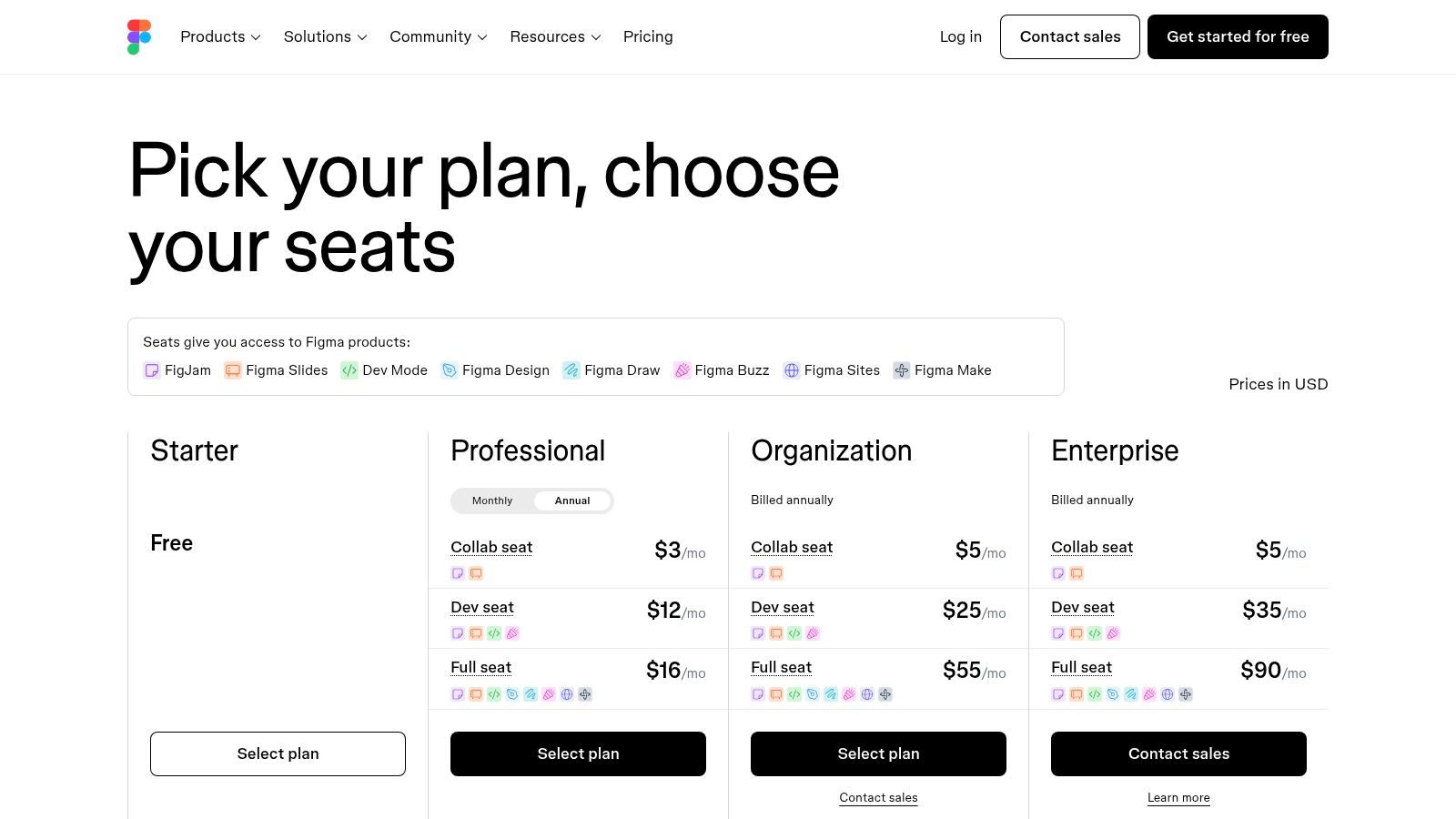
Its core strength lies in multiplayer editing, where multiple designers, developers, and stakeholders can simultaneously work on or comment within the same file. The platform's component-based system and shared libraries are crucial for maintaining design consistency across large-scale projects and distributed teams, making it one of the best design collaboration tools available.
Core Features & Use Cases
- Real-Time Collaboration: Multiple users can design, comment, and iterate in the same file at the same time, perfect for remote workshops and paired design sessions.
- Dev Mode: Provides developers with code-ready specs, assets, and a component playground, significantly streamlining the design-to-development handoff process.
- FigJam & Slides: Integrated whiteboarding and presentation tools allow teams to manage the entire project lifecycle, from ideation to stakeholder presentations, without leaving the ecosystem.
- Community Ecosystem: Access a vast library of free and paid plugins, widgets, and templates to automate tasks and accelerate workflows.
Pricing and Limitations
Figma offers a generous free tier for individuals. Paid plans start with the Professional plan at $12 per editor/month (billed annually) and the Organization plan at $45 per editor/month, which adds advanced security and design system analytics. While powerful, its granular seat-based pricing can become complex and costly for large organizations, especially when forecasting costs for different user roles (editor, viewer, etc.).
Website: https://www.figma.com/pricing/
2. Adobe Creative Cloud for Teams
Adobe Creative Cloud for Teams is the enterprise-grade solution for organizations that rely on Adobe's industry-standard suite of creative applications. It packages over 20+ apps like Photoshop, Illustrator, and Premiere Pro with powerful collaboration features designed for centralized management. This offering moves beyond individual subscriptions by providing shared Creative Cloud Libraries, coediting capabilities, and robust administrative controls for managing users and brand assets at scale.
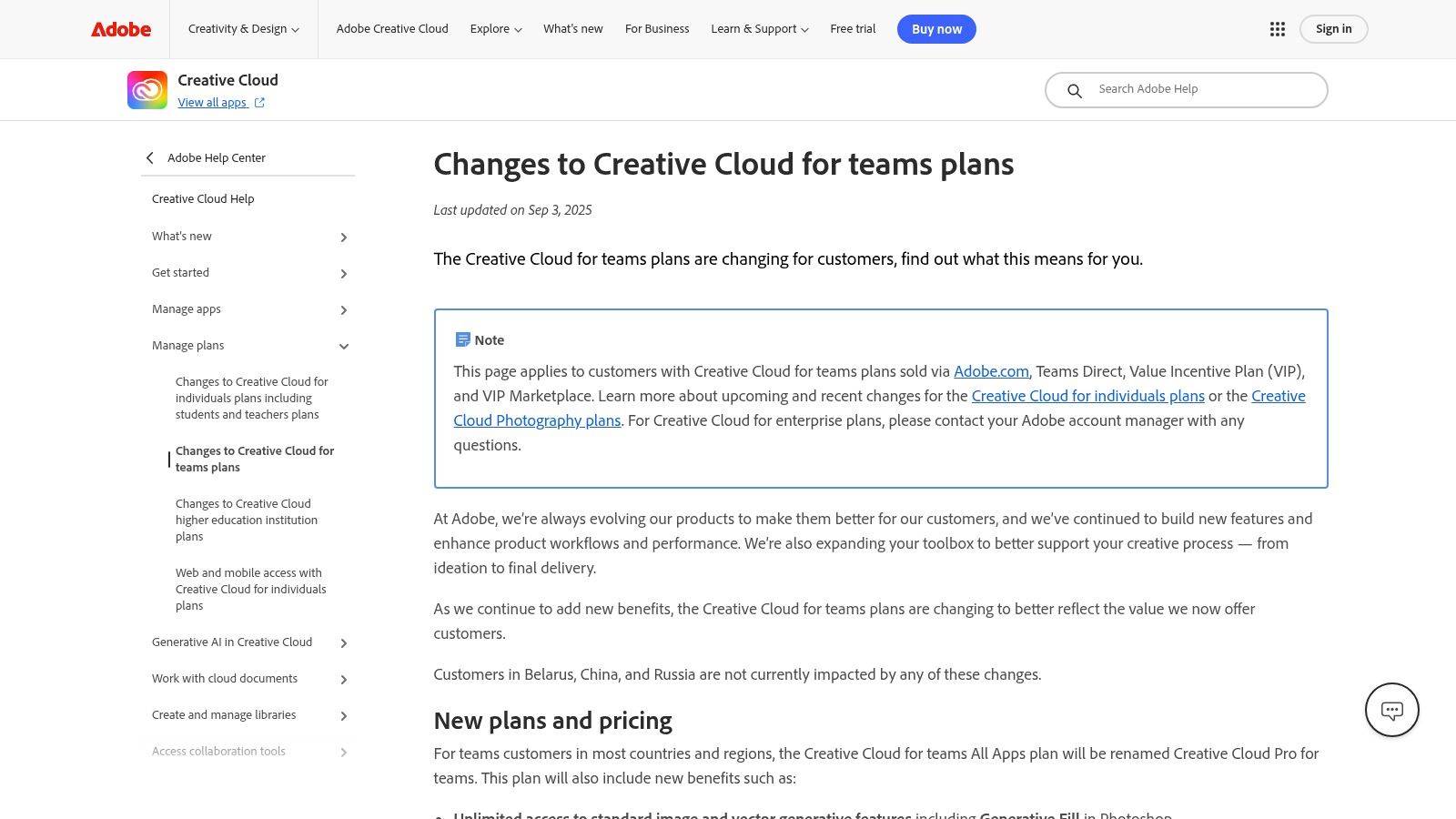
Its main advantage is creating a unified ecosystem where designers, videographers, and marketers can access consistent brand assets, fonts, and color palettes directly within their native apps. This centralized approach ensures brand consistency across all creative outputs, from web graphics to video productions, making it one of the best design collaboration tools for established creative departments. Integrating tools with a clear creative brief template ensures that every project starts with strategic alignment.
Core Features & Use Cases
- Shared Creative Cloud Libraries: Centralize brand assets like logos, colors, and components, allowing team members to access and use them directly across all Adobe apps, ensuring consistency.
- Generative AI & Stock Integration: Includes unlimited standard Firefly generative AI credits and seamless access to Adobe Stock assets, speeding up the content creation process.
- Enterprise Administration: Features an Admin Console for centralized license management, single sign-on (SSO) integration, and advanced security, simplifying procurement and user onboarding.
- Cross-App Workflows: Ideal for multi-disciplinary teams that need to hand off projects between different tools, such as moving a design from Illustrator to After Effects for animation.
Pricing and Limitations
Adobe Creative Cloud for Teams plans are priced per user. The All Apps plan is approximately $84.99 per user/month, with Single App plans also available. Adobe has announced price increases for 2025, which organizations should factor into their budget. While incredibly powerful, the suite’s resource-intensive desktop applications can be demanding on lower-spec hardware, and the variety of plan names can sometimes be confusing for new administrators.
Website: https://helpx.adobe.com/creative-cloud/apps/manage-plans/changes-to-teams-plan.html
3. Sketch
Sketch was one of the original pioneers in vector-based UI design, offering a lightweight and focused alternative to legacy software. Its strength has always been its native macOS performance, providing a smooth and responsive experience for designers who prefer the Apple ecosystem. While it began as a desktop-only application, Sketch has evolved to include a robust web platform where teams can collaborate effectively.
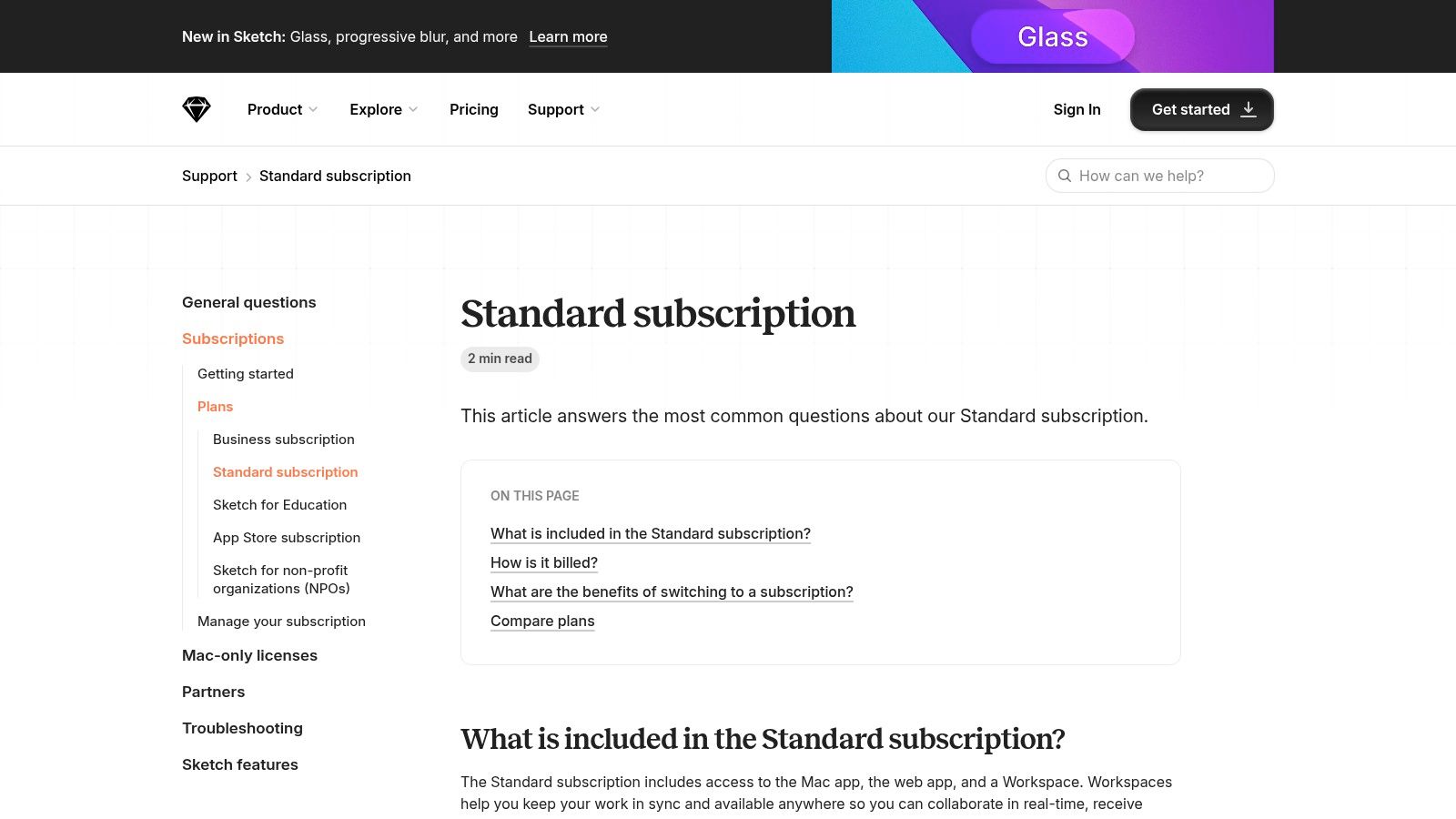
The platform now centers around a collaborative Workspace, where Mac-based designers can co-edit in real-time while stakeholders and developers participate via any web browser. This hybrid model allows teams to leverage native app power for creation while offering universal web access for feedback, handoff, and viewing. Its straightforward pricing and unlimited free viewers make it a cost-effective choice for Mac-centric teams looking for one of the best design collaboration tools. The platform is also an excellent tool for designers looking to create stunning portfolios, and you can see some excellent examples that could have been built using Sketch by reviewing these creative portfolio examples.
Core Features & Use Cases
- Native Mac Editor: Offers a highly polished and performant design experience optimized for macOS, ideal for designers who prioritize speed and a native feel.
- Web-Based Collaboration: Unlimited free viewers can comment, inspect designs, and download assets directly from their browser, streamlining developer handoff and stakeholder reviews.
- Shared Libraries & Workspaces: Centralize design systems, components, and brand assets in a shared cloud workspace to ensure consistency across all projects and team members.
- Version History: Easily track changes and restore previous versions of a design file, providing a safety net and clear audit trail for iterative work.
Pricing and Limitations
Sketch does not offer a free-forever editor tier. Its primary offering is the Standard plan at $10 per editor/month (billed annually), which includes unlimited free viewers. The Business plan, priced at $20 per editor/month, adds features like SSO, unlimited cloud storage, and advanced user permissions. The main limitation is its Mac-only editor, which restricts Windows and Linux users to view-only access via the web app, creating a potential barrier for cross-platform design teams.
Website: https://www.sketch.com/support/subscriptions/plans/standard/
4. Miro
Miro has carved out a niche as the leading online collaborative whiteboard, extending far beyond simple brainstorming. It serves as a central hub for the messy, non-linear parts of the design process, including research synthesis, user journey mapping, and strategic planning. By providing an infinite canvas, Miro empowers distributed teams to visualize complex ideas and align on project direction before moving into high-fidelity design tools.
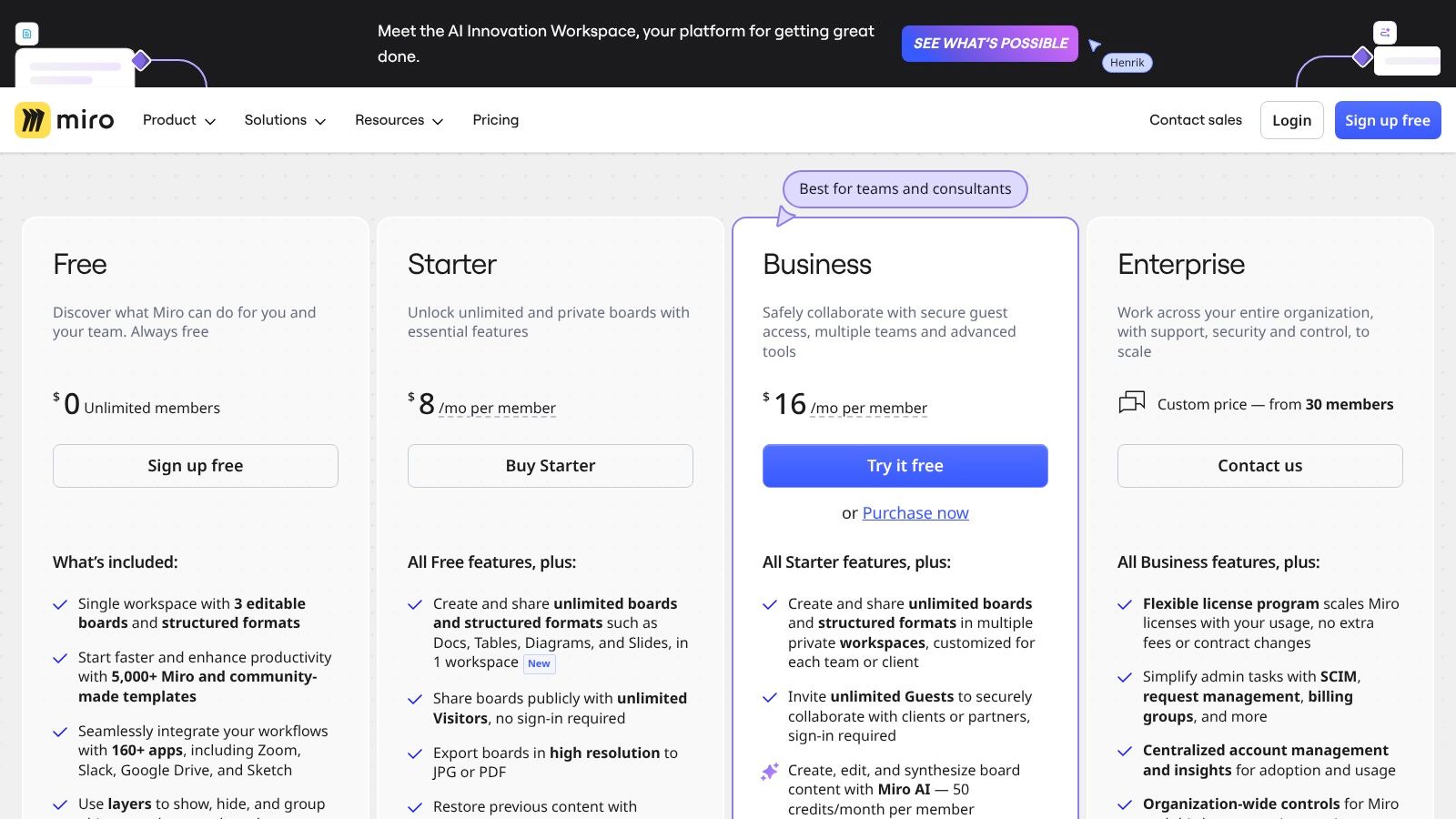
Its primary advantage is its sheer versatility and extensive integration ecosystem. Teams can embed Jira tickets, live website previews, and user feedback directly onto a board, creating a single source of truth for the entire discovery phase. This makes Miro one of the best design collaboration tools for ideation and workshops, fostering an environment where all stakeholders, regardless of their technical skill, can contribute effectively. For more insights on managing such collaborative efforts, explore strategies for creative team management.
Core Features & Use Cases
- Infinite Whiteboard: An endless canvas equipped with sticky notes, diagrams, and over 3,600 shapes is perfect for user story mapping, retrospectives, and virtual workshops.
- Miro AI: Leverages artificial intelligence to summarize discussions, generate ideas from prompts, and automatically create diagrams, accelerating the initial stages of a project.
- Extensive Integrations: Deep connections with tools like Jira, Azure DevOps, Slack, and Zoom allow for seamless workflow transitions and data consolidation.
- Rich Template Library: A massive collection of pre-built templates for everything from SWOT analysis to full-scale design sprints helps teams get started quickly.
Pricing and Limitations
Miro offers a free plan with limited boards. Paid plans begin with the Starter tier at $8 per member/month (billed annually) and the Business plan at $16 per member/month, which adds advanced features like single sign-on (SSO). While incredibly powerful, performance can sometimes degrade on boards with thousands of objects, and the per-member pricing model can become expensive for large organizations with many occasional contributors.
Website: https://miro.com/pricing/?utm_source=openai
5. Mural
Mural positions itself as a digital whiteboard built for enterprise-level visual collaboration, excelling in structured facilitation for workshops, brainstorming sessions, and agile ceremonies. While similar to other whiteboarding tools, its key differentiator lies in robust features designed for large organizations, such as advanced security controls, unlimited guest access on higher tiers, and a rich library of frameworks like LUMA. This makes it an ideal choice for teams that frequently involve external stakeholders or require strict governance.
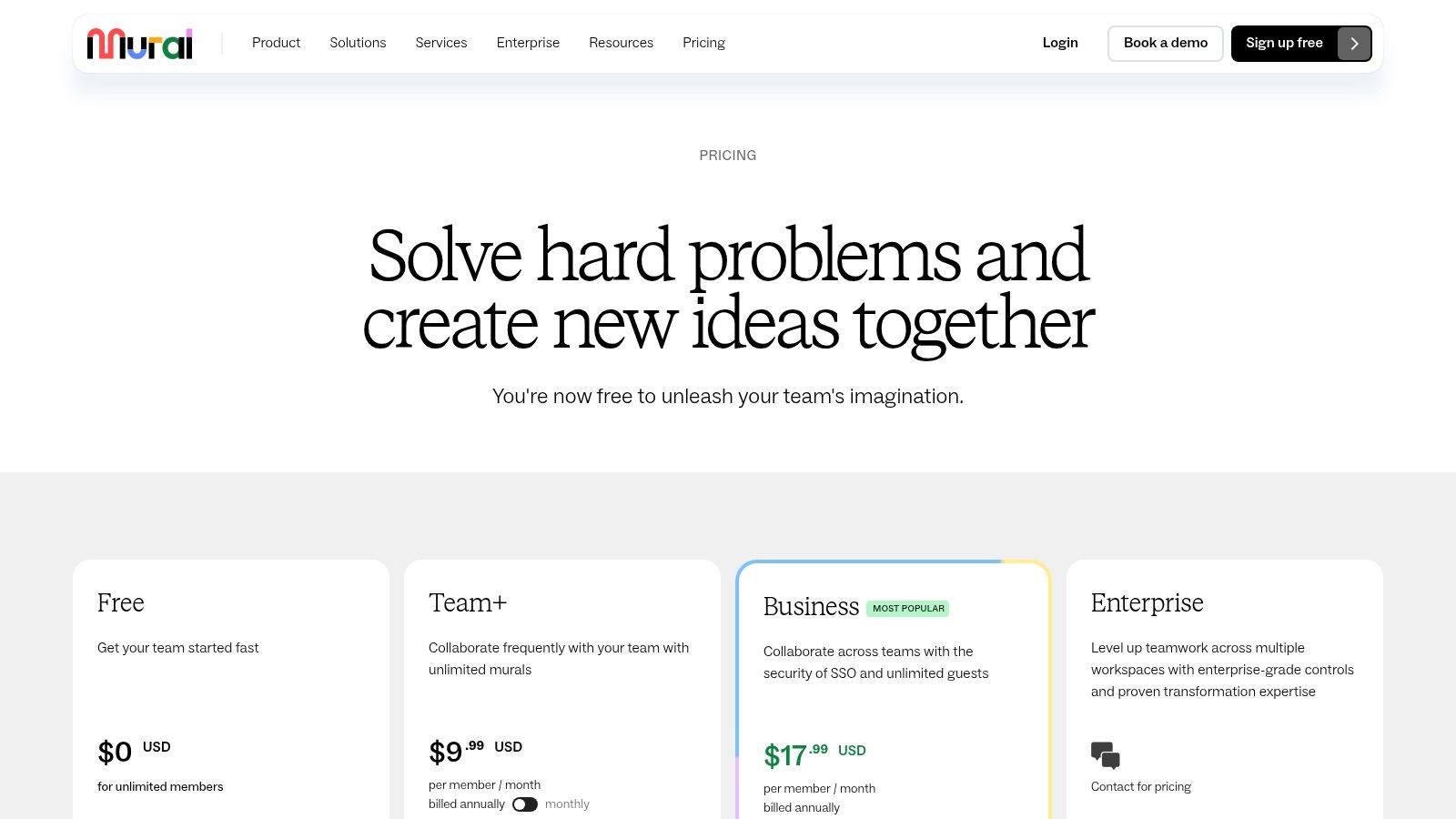
The platform’s focus on guided collaboration is evident through its facilitation toolset, which includes features like private mode, timers, and voting sessions. These tools empower facilitators to run more engaging and productive remote or hybrid meetings. For companies already embedded in the Microsoft or Cisco ecosystems, Mural's deep integrations with tools like Zoom, Webex, and Microsoft Teams make it a seamless addition to their existing workflows, solidifying its place among the best design collaboration tools for structured teamwork.
Core Features & Use Cases
- Facilitator Superpowers™: A suite of tools including timers, voting, and private mode gives meeting hosts granular control over workshops and design sprints.
- Unlimited Visitors: The Business and Enterprise plans allow unlimited external guests, making it cost-effective for collaborating with clients, partners, and stakeholders without adding paid seats.
- Enterprise-Grade Security: Features like SSO, SCIM, data residency controls, and detailed audit logs meet the stringent security and compliance needs of large corporations.
- Template Library: Offers hundreds of pre-built templates for common business activities, from project kickoffs and retrospectives to strategic planning sessions.
Pricing and Limitations
Mural offers a Free plan with limited features and 3 murals. Paid plans include the Team+ plan at $9.99 per member/month and the Business plan at $17.99 per member/month (billed annually), which adds unlimited murals and visitors. While its enterprise features are strong, there is a significant feature overlap with competitors like Miro, which can make the choice difficult. Additionally, some of its most powerful integrations and security features are reserved for the more expensive Business and Enterprise tiers.
Website: https://www.mural.co/pricing?utm_source=openai
6. Zeplin
Zeplin specializes in bridging the gap between design and development, serving as a dedicated workspace for developer handoff. It translates designs from tools like Figma, Sketch, and Adobe XD into an organized, spec-rich environment where engineers can easily access assets, measurements, and code snippets. This focused approach reduces the ambiguity often found in the handoff process, ensuring pixel-perfect implementation.
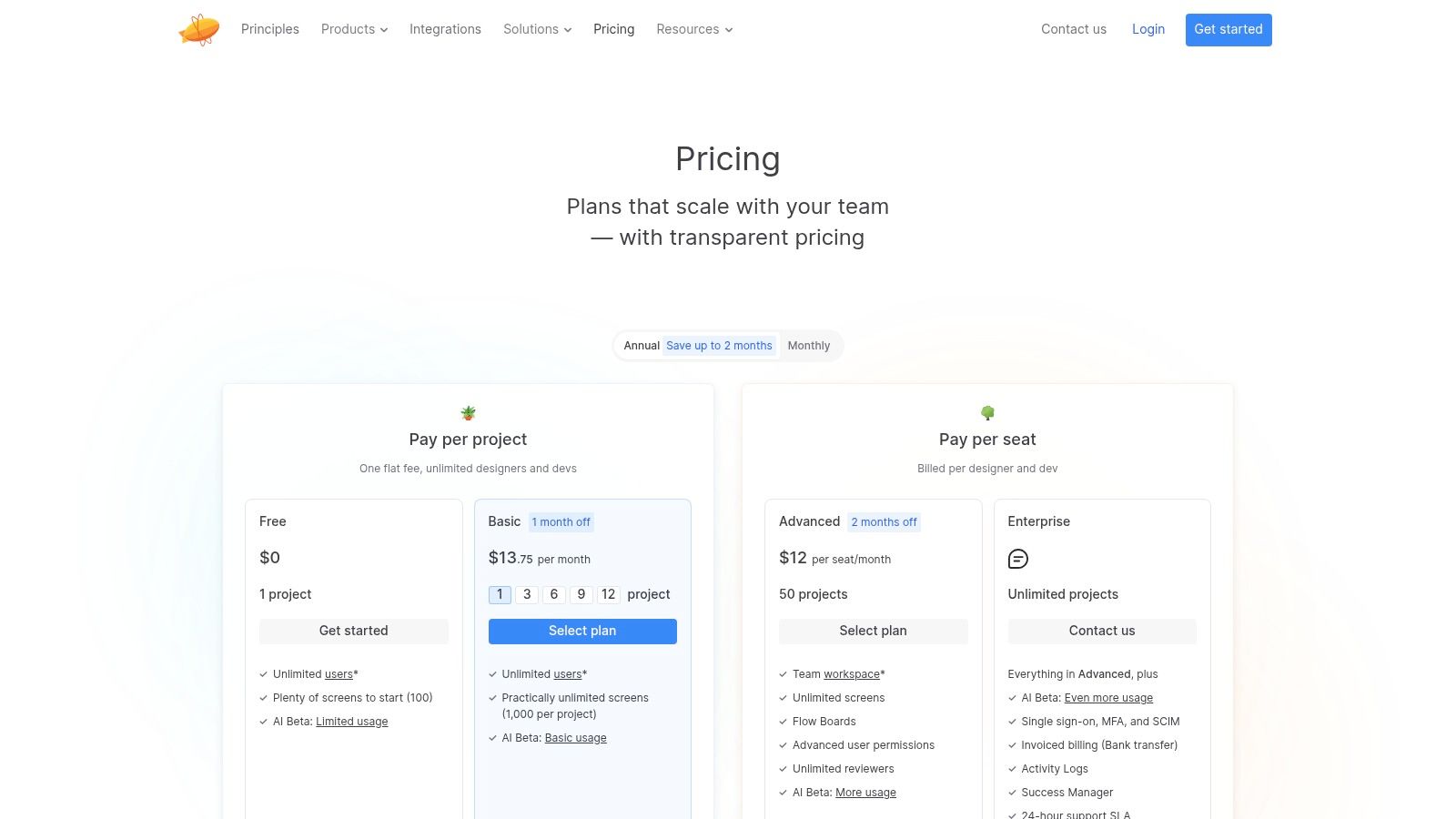
Its primary advantage is creating a single source of truth for approved, build-ready designs. By separating the final designs from the iterative messiness of a design file, Zeplin provides clarity and structure. Developers get exactly what they need without navigating complex design files, while designers maintain control over what gets published, making it one of the best design collaboration tools for engineering teams.
Core Features & Use Cases
- Structured Handoff: Organizes screens into flows and sections, providing developers with clear user journeys and contextual information.
- Code Snippet Generation: Automatically generates CSS, Swift, and XML code snippets tailored to various platforms, accelerating the development cycle.
- Version Control & Diffs: Visually compares screen versions to highlight changes, ensuring developers are always working from the latest approved design. For a deeper look, you can find a comprehensive breakdown of design feedback tools like Zeplin on creativize.net.
- Deep Integrations: Connects seamlessly with Jira, Storybook, Slack, and VS Code to embed design context directly into development workflows.
Pricing and Limitations
Zeplin offers a free plan for a single project. Paid plans include the Team plan at $10 per seat/month (billed annually) for multiple projects and the Organization plan at $16 per seat/month for advanced roles and permissions. An Enterprise plan is available for enhanced security and governance. While its focused workflow is a strength, it introduces another tool into the stack, which can feel redundant for teams already adept with Figma's Dev Mode.
Website: https://zeplin.io/pricing?utm_source=openai
7. Canva
Canva has expanded far beyond its social media graphic roots to become a comprehensive visual collaboration suite. It excels in environments where non-designers, like marketers and operations staff, need to create on-brand assets quickly. The platform is built around an extensive library of templates and an intuitive drag-and-drop editor, democratizing design and enabling rapid content creation across entire organizations.
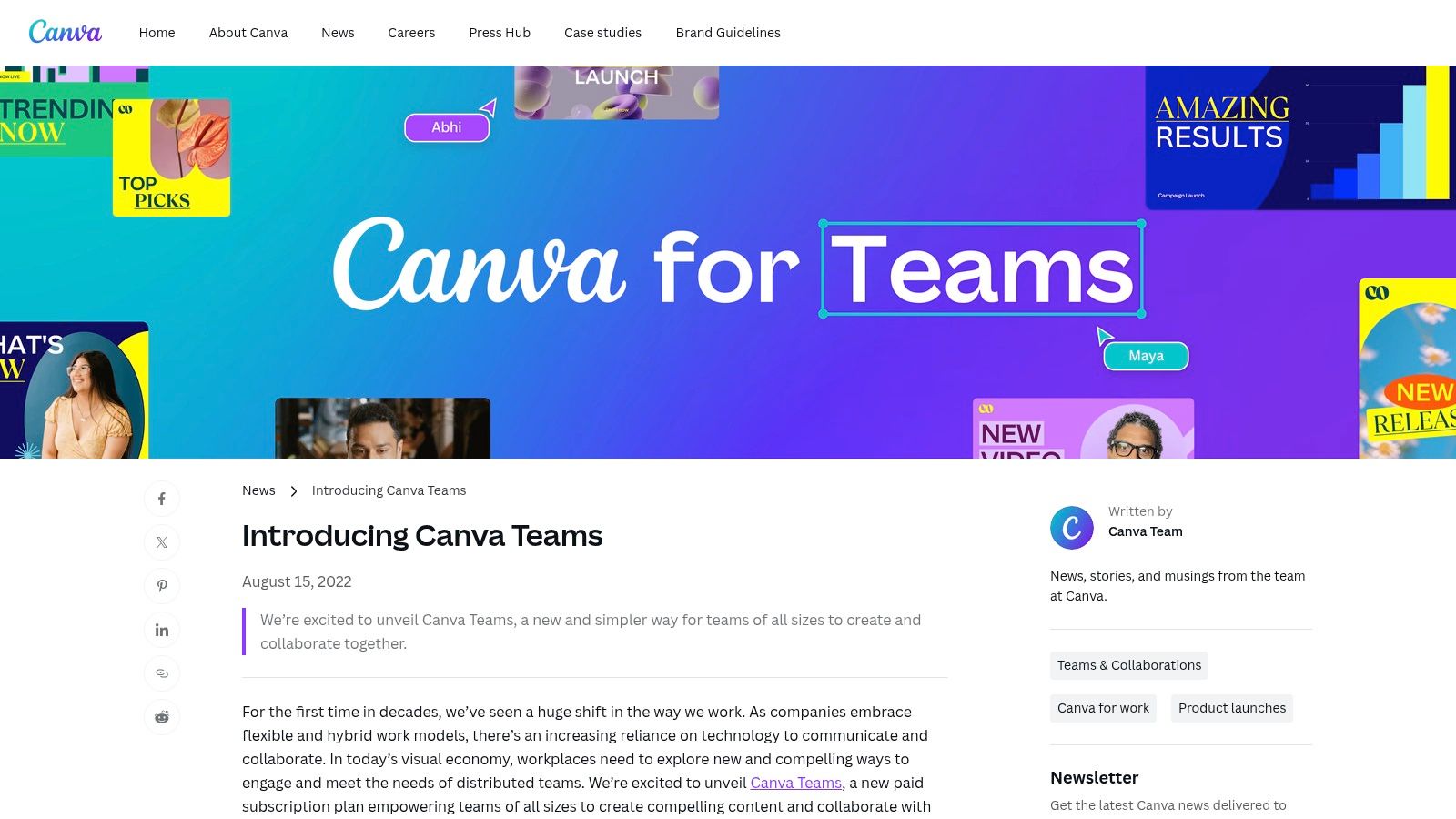
Its core advantage is its accessibility and focus on brand management for mixed-skill teams. Features like Brand Kits lock down logos, fonts, and color palettes, ensuring consistency even when hundreds of employees are creating content. This makes it one of the best design collaboration tools for marketing departments and businesses focused on scaling their brand presence without requiring specialized design software for every team member.
Core Features & Use Cases
- Real-Time Co-editing & Approvals: Teams can work together simultaneously on presentations, documents, and designs, with built-in workflows to request and provide feedback or formal sign-off.
- Brand Kits & Shared Folders: Centralize brand assets to maintain consistency and organize projects by campaign or department, ensuring everyone uses the correct, up-to-date materials.
- All-in-One Content Suite: Create a wide range of assets including social media posts, videos, whiteboards for brainstorming, and formal presentations without leaving the platform.
- Extensive Content Library: Gain access to millions of stock photos, videos, audio tracks, and graphics to accelerate the content creation process.
Pricing and Limitations
Canva offers a functional free plan for individuals. The Canva for Teams plan starts at $14.99 per month for the first user, with tiered pricing for additional team members. An Enterprise plan provides advanced administration and SSO. While its ease of use is a major strength, it lacks the advanced vector editing and prototyping capabilities of professional UI/UX tools, making it unsuitable for complex digital product design.
Website: https://www.canva.com/newsroom/news/introducing-canva-for-teams/
8. Webflow
Webflow bridges the gap between design and production by offering a visual, no-code platform where teams can design, build, and launch responsive websites. It’s a unique entry in the list of best design collaboration tools because its collaborative features are directly tied to a live production environment. This allows designers, copywriters, and marketers to work together on the actual website, not just a static prototype, radically accelerating the go-to-market timeline.
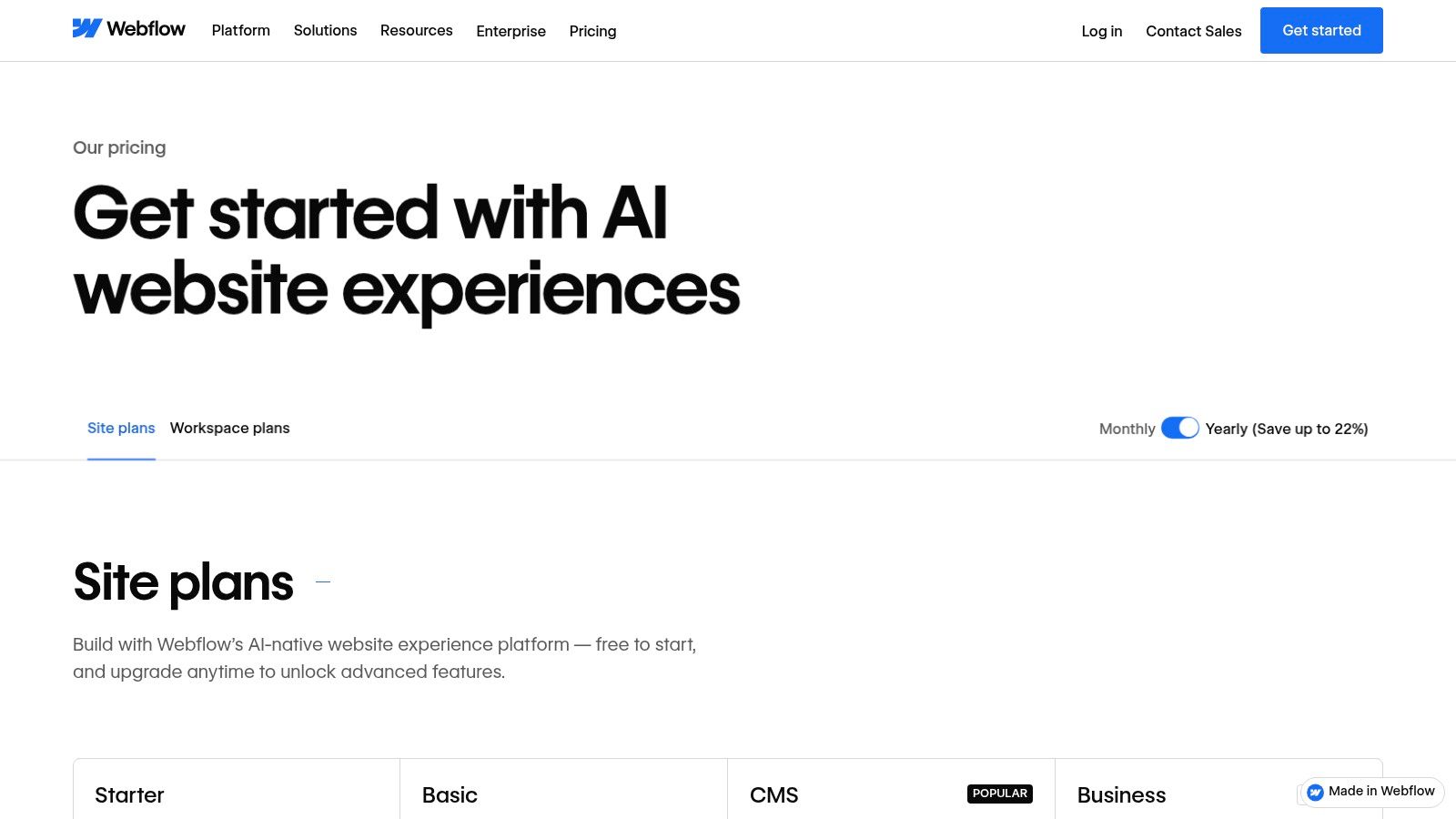
Its strength is in empowering designers to ship pixel-perfect, production-ready sites without relying on engineering resources. The platform’s robust Content Management System (CMS) allows content editors to update text and images directly on the page, while designers maintain control over the site structure and style. This parallel workflow prevents bottlenecks and ensures brand consistency from design through to launch.
Core Features & Use Cases
- Live Collaboration: Multiple users with "editor" access can update CMS content and copy directly on a staging or live site, while designers work on the underlying structure in the Visual Designer.
- Designer & CMS: A powerful combination that separates content from design, enabling marketing teams to manage blogs and landing pages while designers control the global brand styles.
- Staging & Versioning: Provides a safe environment to test changes before pushing them live, with the ability to restore previous versions instantly, minimizing the risk of breaking the production site.
- Enterprise-Grade Support: Offers advanced security, guaranteed SLAs, and dedicated support for large teams and high-traffic marketing sites that require reliability and compliance.
Pricing and Limitations
Webflow’s pricing is multifaceted, with separate costs for Workspaces (per-seat plans for collaboration) and Site Plans (hosting tiers). Workspace plans include a free starter option, with paid tiers like Core at $19 per user/month and Growth at $49 per user/month (billed annually). Site Plans vary based on traffic and features, starting from $14/month. This dual pricing structure can be complex to manage and may become costly for organizations with many collaborators or multiple high-traffic websites.
Website: https://webflow.com/pricing?utm_source=openai
9. Axure RP + Axure Cloud
Axure RP is a powerful, highly specialized tool focused on creating complex, logic-driven interactive prototypes. While many tools prioritize visual design, Axure excels at mapping out intricate user flows, conditional logic, and dynamic content without writing any code. It is the go-to choice for UX designers and business analysts who need to build functional prototypes that feel like real applications, complete with variables and adaptive views.
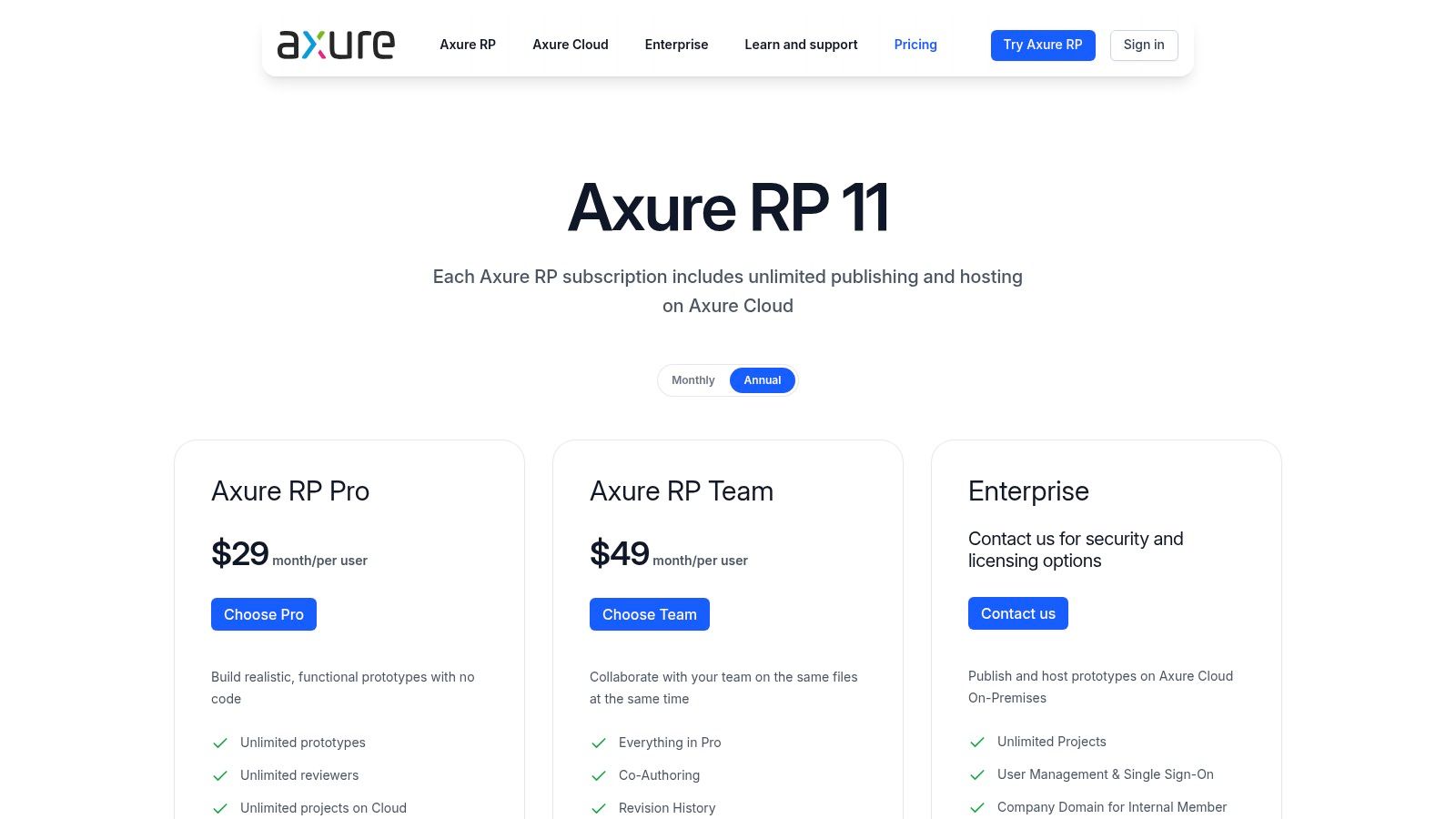
The collaboration aspect is handled through Axure Cloud, where designers can publish their prototypes for stakeholder review. This platform supports co-authoring, revision history, and detailed feedback directly on the prototype. This combination makes Axure one of the best design collaboration tools for projects where functional fidelity and complex logic are more critical than pixel-perfect visual polish early in the process.
Core Features & Use Cases
- Advanced Interactivity: Build prototypes with conditional logic, dynamic content, and variables to simulate complex application behavior, perfect for user testing intricate workflows.
- Co-authoring & Revision History: The Axure for Teams plan allows multiple designers to work on the same file, check in changes, and maintain a complete version history.
- Axure Cloud for Feedback: Publish prototypes to the cloud and invite unlimited reviewers to leave comments directly on the screen, streamlining stakeholder communication.
- Detailed Specifications: Automatically generate comprehensive documentation, including wireframes, annotations, and interaction notes, for a seamless developer handoff.
Pricing and Limitations
Axure offers subscription plans for its RP (desktop app) and Cloud (collaboration platform) products. The Axure RP Pro plan starts at $25 per user/month (billed annually), while the Axure RP Team plan, which includes co-authoring, is $42 per user/month. While its prototyping capabilities are unmatched for complexity, Axure has a steeper learning curve than many modern UI tools, and its visual design interface can feel less intuitive compared to platforms like Figma or Sketch.
Website: https://www.axure.com/pricing?utm_source=openai
10. Balsamiq
Balsamiq specializes in low-fidelity wireframing, offering a tool that prioritizes speed and clarity over visual polish. Its distinct, sketch-like aesthetic encourages stakeholders to focus on layout and functionality rather than getting distracted by colors and fonts. This makes it an excellent choice for the early stages of the design process, where rapid ideation and clear, early-stage feedback are paramount.
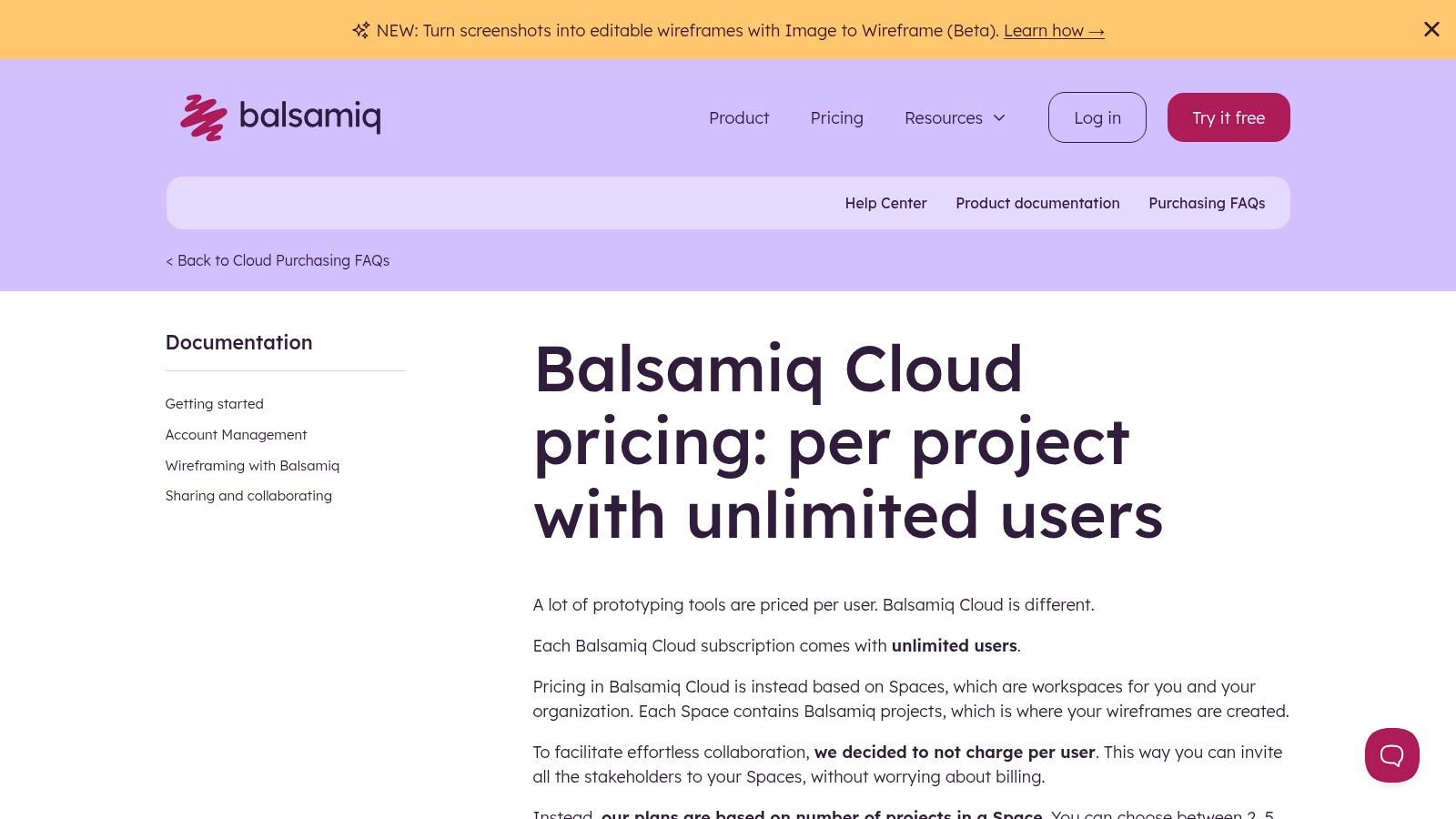
Its core collaborative strength lies in Balsamiq Cloud, where pricing is based on the number of active projects, not individual user seats. This unique model allows entire teams, clients, and stakeholders to comment and review wireframes without incurring additional costs, making it one of the best design collaboration tools for projects requiring broad, cross-functional input without complex user management. It's a key part of the toolkit for many teams, complementing a broader creative project management software stack.
Core Features & Use Cases
- Rapid Wireframing: A vast library of pre-built, sketch-style UI components allows for quick assembly of user flows and layouts, ideal for brainstorming and workshop sessions.
- Unlimited Users: Balsamiq Cloud plans support unlimited users, making it easy to share projects with anyone for feedback without worrying about per-seat licensing costs.
- Focus on Structure: The low-fidelity nature ensures conversations stay centered on usability and structure, preventing premature discussions about visual design.
- Simple Sharing & Feedback: Projects are shared via a simple link, where collaborators can add comments directly onto the wireframes to streamline the feedback loop.
Pricing and Limitations
Balsamiq Cloud pricing is based on the number of active projects. The 2 Projects plan is $9/month, the 20 Projects plan is $49/month, and the 200 Projects plan is $199/month (all billed monthly). Enterprise options with SSO and SLAs are also available. Its primary limitation is its intentional focus on low-fidelity; it is not suitable for creating high-fidelity designs or interactive prototypes. Additionally, the desktop app is being retired, with sales ending in December 2026 and support ending in 2027.
Website: https://balsamiq.com/support/sales/cloud/pricing/?utm_source=openai
11. Lucidspark
Lucidspark carves out a unique space in the visual collaboration market by seamlessly integrating its digital whiteboard with Lucidchart, its powerful diagramming tool. This dual-platform approach allows teams to transition smoothly from unstructured brainstorming sessions to formal, structured documentation like user flows or sitemaps. It's a powerful combination for organizations that need to connect initial ideation directly to actionable planning and process documentation.
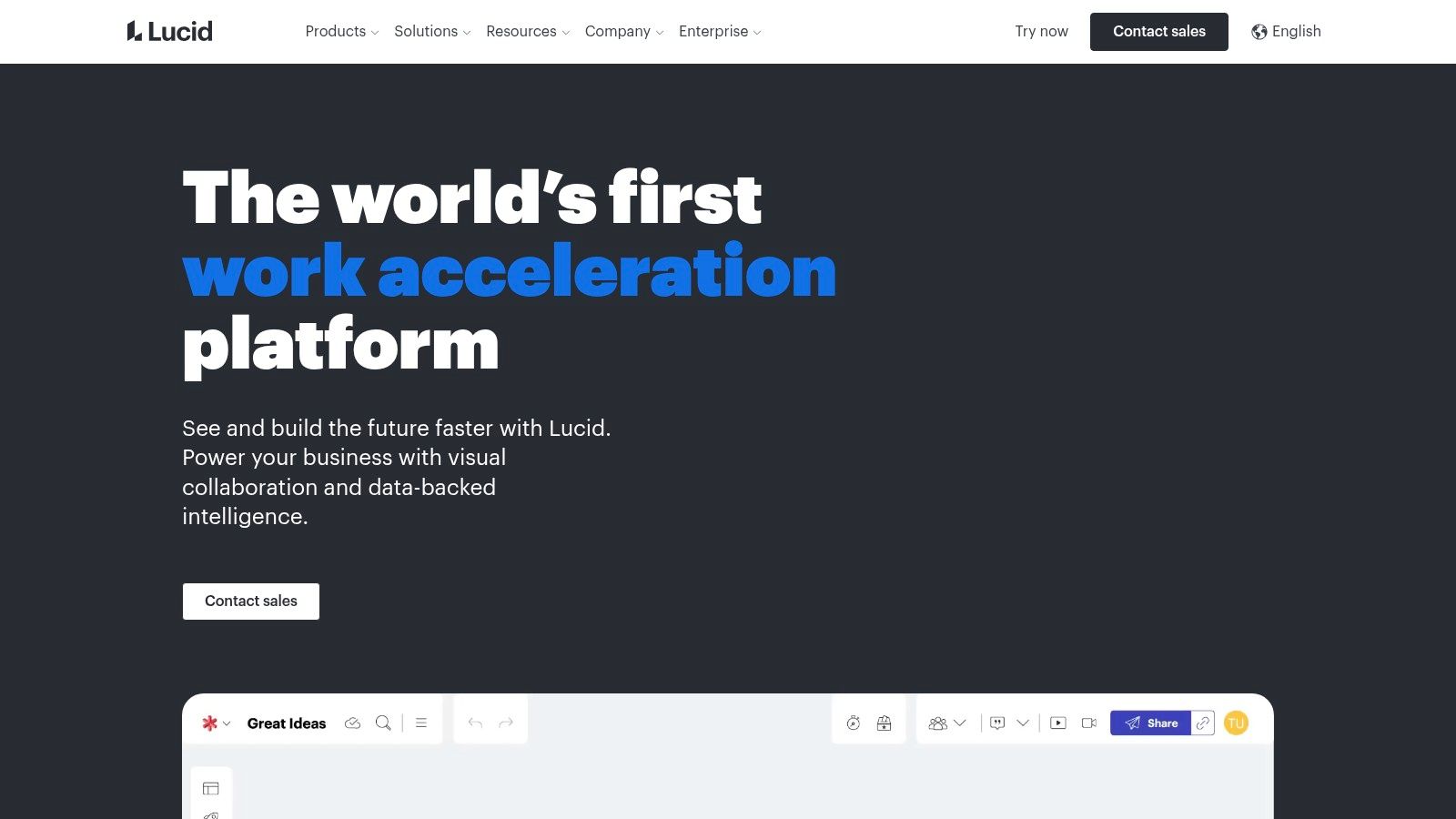
The platform is designed for large-scale enterprise use, offering features that facilitate structured workshops and collaborative sessions. Facilitators can leverage tools like voting, timers, and breakout boards to manage group activities effectively. Its AI capabilities further enhance productivity by automatically clustering ideas and summarizing key takeaways, making it one of the best design collaboration tools for processing large amounts of qualitative data.
Core Features & Use Cases
- Lucidchart Integration: Move ideas from a freeform Lucidspark board to a structured Lucidchart diagram with a single click, ideal for creating workflows from brainstormed concepts.
- Facilitation Tools: Built-in timers, voting, and breakout boards help run effective remote or hybrid workshops, user story mapping sessions, and retrospectives.
- AI-Powered Assistance: Use AI to automatically group sticky notes by theme, generate new ideas based on existing content, and summarize entire boards for quick stakeholder updates.
- Universal Canvas: A single, unified space for teams to use sticky notes, freehand drawing, shapes, and imported documents to build a comprehensive project hub.
Pricing and Limitations
Lucidspark offers a limited free plan for individuals. Paid plans start with the Individual tier at $7.95 per month and the Team plan at $9 per user/month (billed annually). For enterprise features and advanced integrations, custom pricing is available upon request. While its integrations are extensive, some users find that its feature set for pure whiteboarding can be less expansive than dedicated competitors like Miro in specific niche use cases.
Website: https://lucid.co/?utm_source=openai
12. G2
While not a design tool itself, G2 is an indispensable resource for evaluating and selecting the right software for your team. It’s a comprehensive software marketplace that aggregates verified user reviews, allowing teams to compare the best design collaboration tools based on real-world feedback. Instead of relying solely on marketing materials, G2 provides a transparent view of a tool's strengths and weaknesses from actual users, which is crucial for making an informed purchasing decision.
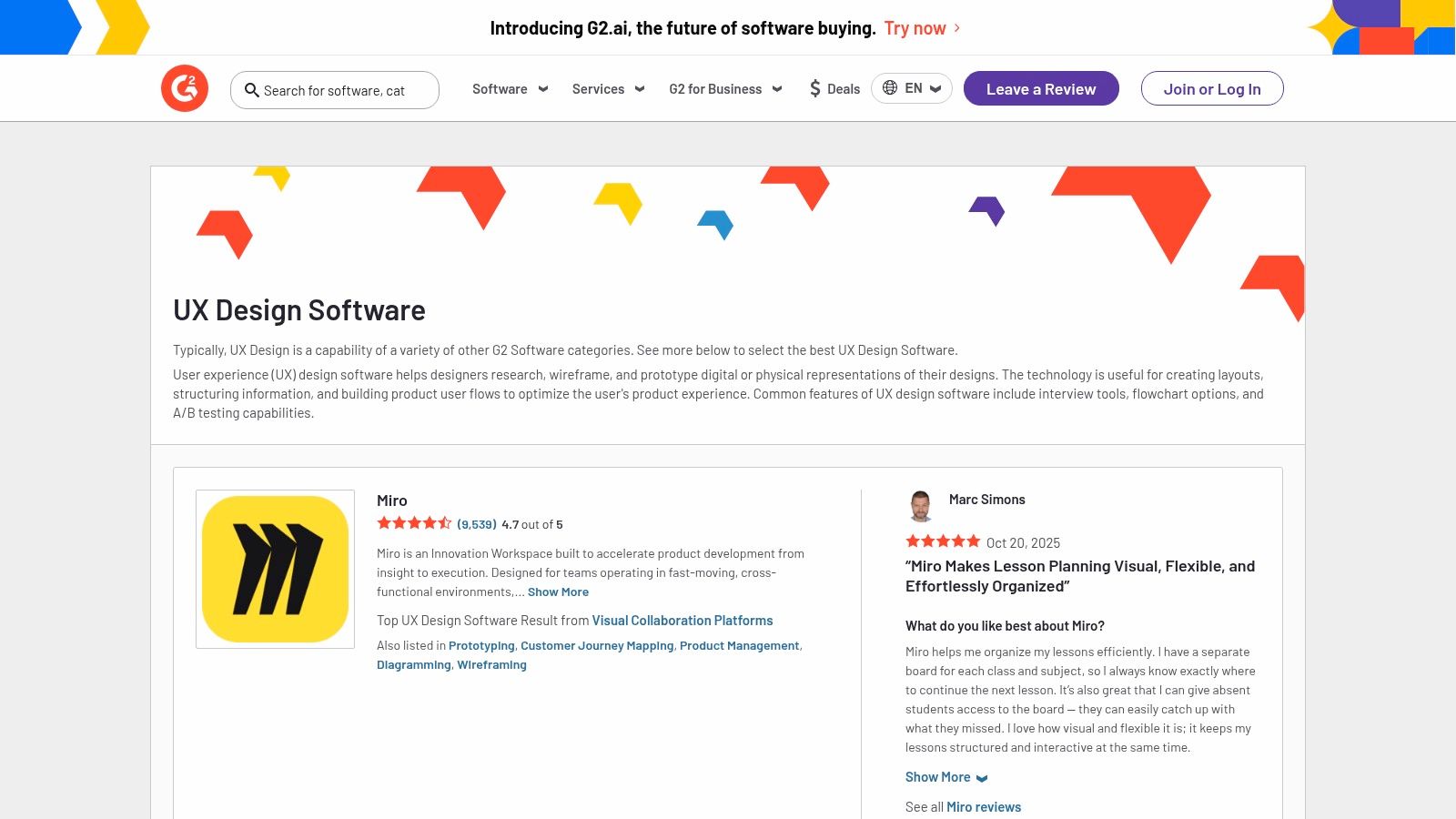
Its power lies in its detailed filtering and side-by-side comparison features. You can quickly shortlist platforms based on company size, user ratings, specific features, and pricing models. The platform’s proprietary Grid reports are particularly useful for identifying market leaders, high performers, and niche innovators in categories like UX design, prototyping, and online whiteboarding, helping you discover tools you might have otherwise missed.
Core Features & Use Cases
- Verified User Reviews: Access thousands of in-depth reviews from peers sharing honest pros, cons, and use-case scenarios to guide your evaluation process.
- Advanced Filtering: Narrow down options by specific criteria like user satisfaction, feature sets, market presence, and company size to find tools tailored to your needs.
- Side-by-Side Comparisons: Directly compare up to four tools at once, evaluating their features, pricing, and user ratings in a clear, structured format.
- Market Grids & Reports: Visualize the competitive landscape to quickly identify established leaders and emerging challengers within the design collaboration software market.
Pricing and Limitations
G2 is free to use for browsing and research. Vendors pay for enhanced profiles and lead generation services. The primary limitation is that some listings and category placements are sponsored, which can influence visibility. Additionally, while G2 strives for accuracy, pricing information may occasionally lag behind a vendor’s official updates, so it's always best to verify costs directly on the tool’s website.
Website: https://www.g2.com/software/ux-design?utm_source=openai
Design Collaboration Tools: Feature & Pricing Comparison
| Tool | Core Features & Capabilities | User Experience & Quality ★★★★☆ | Value & Pricing 💰 | Target Audience 👥 | Unique Selling Points ✨ |
|---|---|---|---|---|---|
| Figma | Real-time collaborative UI/UX design, prototyping, Dev Mode | ★★★★★ Best-in-class collaboration | Premium enterprise pricing, granular seats | Designers, teams, enterprises | Multiplayer editing, plugin ecosystem 🏆 |
| Adobe Creative Cloud Teams | 20+ apps, AI-powered features, admin control | ★★★★☆ Industry-standard, mature tools | Higher cost, enterprise procurement options | Large enterprises, creative teams | Generative AI, Creative Cloud Libraries ✨ |
| Sketch | Mac-first UI design, real-time co-editing, version history | ★★★★☆ Polished Mac-native performance | Annual pricing, unlimited free viewers | macOS designers, teams | Unlimited free viewers, simple pricing |
| Miro | Collaborative whiteboard, infinite boards, AI content generation | ★★★★☆ Great for ideation & planning | Per-member pricing can be costly | Teams of all sizes | Extensive integrations, templates |
| Mural | Workshop facilitation, guest access, enterprise security | ★★★★ Facilitation-rich collaboration | Higher tiers for full features | Enterprises, facilitators | Unlimited external guests, robust security |
| Zeplin | Design-to-development handoff, annotations, version diffs | ★★★★ Reduces handoff ambiguity | Flexible pricing models | Designers & developers | Unlimited free reviewers, project governance |
| Canva | Visual collaboration, templates, brand kits, content scheduler | ★★★★ Fast onboarding, user-friendly | Confusing teams pricing, good nonprofit program | Non-designers, marketing teams | Large stock library, brand controls |
| Webflow | No-code web design, CMS, real-time collaboration | ★★★★ Enables code-free site builds | Complex pricing; per-site & per-seat | Marketers, designers, agencies | Production-ready sites, strong CMS |
| Axure RP + Axure Cloud | Advanced prototyping, logic/interactions, cloud sharing | ★★★★ Best for complex prototypes | Procurement-friendly, steeper learning curve | UX pros, complex projects | Complex interactive logic, unlimited reviewers |
| Balsamiq | Low-fidelity wireframing, fast ideation, unlimited cloud users | ★★★☆ Rapid feedback, simple use | Project-based pricing; desktop app retiring | Early-stage designers, stakeholders | Unlimited users, fast wireframing |
| Lucidspark | Visual whiteboard, AI-assisted ideation, Lucidchart integration | ★★★★ Enterprise-scale collaboration | Pricing often requires sales contact | Enterprise teams, strategists | AI clustering & summarizing |
| G2 | Software marketplace, verified reviews, feature comparisons | ★★★★ Trusted peer feedback | Free to use, some sponsored listings | Buyers, researchers, decision-makers | Side-by-side tool comparisons |
Choosing Your Team's Next Creative Powerhouse
Navigating the landscape of design collaboration tools can feel overwhelming, but making an informed choice is a pivotal step toward unlocking your team's full creative potential. As we've detailed, the market offers a diverse spectrum of solutions, each tailored to specific workflows, team sizes, and project complexities. There is no single "best" tool, only the tool that is best for your unique context.
The journey from a blank canvas to a finished product is rarely linear. It involves brainstorming, wireframing, prototyping, feedback, and handoff. Your chosen toolstack must seamlessly support each phase. An all-in-one powerhouse like Figma has fundamentally changed the game with its browser-based, real-time collaboration, making it a default for many startups and agile teams. In contrast, legacy giants like Adobe Creative Cloud offer an unparalleled depth of specialized applications, catering to enterprises that require a robust, interconnected ecosystem for everything from vector illustration to video editing.
Matching the Tool to the Task
The key takeaway from our deep dive is the importance of aligning a platform's core strengths with your team's primary needs.
-
For Ideation & Brainstorming: If your primary bottleneck is in the early, messy stages of ideation, tools like Miro, Mural, and Lucidspark are invaluable. Their infinite digital whiteboards are designed to capture abstract thoughts, map user flows, and facilitate dynamic workshop sessions, turning chaos into structured concepts.
-
For UI/UX & Prototyping: When fidelity and interactivity are paramount, your focus should shift. Sketch remains a strong contender for macOS-native teams, while Axure RP provides unrivaled power for creating complex, data-driven prototypes. For teams needing a simple, low-fidelity solution to validate ideas quickly, Balsamiq's hand-drawn aesthetic cuts through the noise and focuses conversations on structure and flow.
-
For Design-to-Dev Handoff: Bridging the gap between design and development is a critical, often frustrating, step. Zeplin is purpose-built to solve this, creating a single source of truth for specs, assets, and code snippets that developers can easily access and implement.
Strategic Implementation and Final Considerations
Beyond features, several practical factors should guide your decision. Consider your budget, the learning curve for your team, and, most importantly, integration capabilities. Does the tool play well with your existing project management software like Jira or your communication hub like Slack? A powerful tool that creates an information silo can do more harm than good.
We recommend a structured evaluation process:
- Identify Your Core Pain Points: Where does your current workflow break down? Is it feedback collection, version control, or developer handoff?
- Shortlist 2-3 Contenders: Based on our analysis, select the tools that most directly address your identified pain points.
- Run a Pilot Project: Before committing to a company-wide rollout, task a small, cross-functional team with completing a real project using a trial version. This provides invaluable, real-world insights that a feature list can never capture.
Ultimately, the best design collaboration tools are those that fade into the background, becoming an invisible extension of your team's creativity. They should reduce friction, foster communication, and empower every stakeholder, from the designer to the developer to the CEO, to contribute effectively. Choose the platform that not only fits your workflow today but also has the flexibility to scale with your ambitions for tomorrow.
The most powerful tool is only as effective as the talent behind it. If you're looking to augment your team with proven creative professionals who have mastered platforms like Figma, Adobe CC, and Webflow, Creativize connects you with a global network of vetted designers, animators, and strategists. Find the expert you need to elevate your projects and maximize the ROI on your new software stack by visiting Creativize today.

